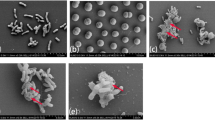Abstract
Mass growth of blue-green algae in eutrophic water bodies leads to a large amount of toxins, e.g. microcystins (MCs). How to remove MCs from water bodies is an environmental problem. In this study, an algicidal bacterium Ochrobactrum sp. FDT5 was isolated and found to have microcystin-LR (MC-LR) degradation capacity, which could be enhanced by a domestication process. The FDT5 cell density, MC-LR initial concentration, temperature, and pH on the degradation of MC-LR were investigated. The results indicated that the initial cell density of FDT5 and the initial concentration of MC-LR could influence MC-LR degradation. The optimum conditions were under the temperature of 35°C with pH of 7.0. After FDT5 was exposed to MC-LR for 2 days, FDT5 cells produced active cellular components that degraded MC-LR. These cellular components were heat-inactivated and removed when FDT5 cells were removed by filtration.



Similar content being viewed by others
References
Amado LL, Garcia ML, Ramos PB, Yunes JS, Monserrat JM (2011) Influence of a toxic Microcystis aeruginosa strain on glutathione synthesis and glutathione-S-transferase activity in common carp Cyprinus carpio (Teleostei: Cyprinidae). Arch Environ Contam Toxicol 60:319–326
Carmichael WW (1994) Toxins of cyanobacteria. Sci Am 270:78–86
Francis G (1878) Poisonous Australian lake. Nature 18:11–12
Fukuda R, Ogawa H, Nagata T, Koike I (1998) Direct determination of carbon and nitrogen contents of natural bacterial assemblages in marine environments. Appl Environ Microbiol 64:3352–3358
Ishii H, Nishijima M, Abe T (2004) Characterization of degradation process of cyanobacterial hepatotoxins by a gram-negative aerobic bacterium. Water Res 38:2667–2676
Jang MH, Ha K, Joo GJ, Takamura N (2003) Toxin production of cyanobacteria is increased by exposure to zooplankton. Freshw Biol 48:1540–1550
Lambert TW, Holmes CFB, Hrudey SE (1994) Microcystin class of toxins: health effects and safety of drinking water supplies. Environ Rev 2:167–186
Mohamed ZA, El-Sharouny HM, Ali WS (2007) Microcystin concentrations in the Nile river sediments and removal of microcystin-LR by sediments during batch experiments. Arch Environ Contam Toxicol 52:489–495
Mu R, He Y, Liu S, Wang X, Fan Z (2009) The algicidal characteristics of one algae-lysing FDT5 bacterium on Microcystis aeruginosa. Geomicrobiol J 26:516–521
Nasri AB, Bouaicha N, Fastner J (2004) First report of a microcystin-containing bloom of the cyanobacteria Microcystis spp. in Lake Oubeira, eastern Algeria. Arch Environ Contam Toxicol 46:197–202
Paerl HW, Huisman J (2008) Climate—blooms like it hot. Science 320:57–58
Park HD, Sasaki Y, Maruyama T, Yanagisawa E, Hiraishi A, Kato K (2001) Degradation of the cyanobacterial hepatotoxin microcystin by a new bacterium isolated from a hypertrophic lake. Environ Toxicol 16:337–343
Takenake S, Watanabe MF (1997) Microcystin LR degradation by Pseudomonas aeruginosa alkaline protease. Chemosphere 34:749–757
Valeria AM, Ricardo EJ, Stephan P, Alberto WD (2006) Degradation of microcystin-RR by Sphingomonas sp. CBA4 isolated from San Roque reservoir (Cordoba-Argentina). Biodegradation 17:447–455
Xiao FG, Zhao XL, Tang J, Gu XH, Zhang JP, Niu WM (2009) Necessity of screening water chestnuts for microcystins after cyanobacterial blooms break out. Arch Environ Contam Toxicol 57:256–263
Acknowledgments
The authors would like to acknowledge the support from Grant the National Natural Science Foundation of China 20807011 and 20907010.
Author information
Authors and Affiliations
Corresponding author
Rights and permissions
About this article
Cite this article
Jing, W., Sui, G. & Liu, S. Characteristics of a Microcystin-LR Biodegrading Bacterial Isolate: Ochrobactrum sp. FDT5. Bull Environ Contam Toxicol 92, 119–122 (2014). https://doi.org/10.1007/s00128-013-1170-9
Received:
Accepted:
Published:
Issue Date:
DOI: https://doi.org/10.1007/s00128-013-1170-9




